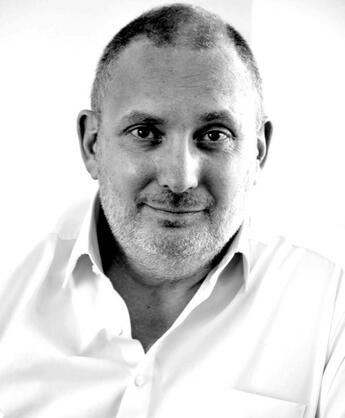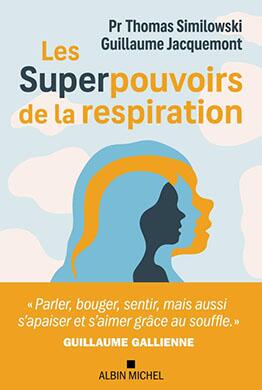
Breathing, that little-known superpower
Guillaume Jacquemont and Thomas Similowski have co-authored the book, Les Superpouvoirs de la respiration (Breathing, that little-known superpower). This interview sheds light on the fascinating links between breathing, the brain and well-being.

Professor of pulmonology and head of the “Respiration, Réadaptation Respiratoire, Sommeil” department at the Pitié-Salpêtrière hospital, he looks back at this automatic gesture we perform thousands of times a day, and its essential impact on our physical and mental health.
What led you to write this book for the general public, and why do you think breathing is such a crucial subject?
Thomas Similowski: Respiratory diseases, and breathing in general, are surprisingly little-known by the general public, and arouse little interest. This is also surprising when you consider that almost 10 million French people are affected by a chronic respiratory disease, and that breath is ubiquitous in culture, as evidenced by the many expressions containing the word in all languages.
The Covid-19 pandemic certainly put this subject in the spotlight, but it didn't last. Now that the crisis has passed, we're back to business as usual, and even in institutions and health plans, breathing remains curiously ignored. So I felt it was important to bring this subject to the fore. I had also co-written a comic strip on respiratory illnesses, with the same aim of informing the general public.
How has your research influenced your approach to the link between breathing and physical and mental well-being?
T. S.: I'm a rather unusual pulmonologist, because unlike most of my colleagues, who naturally focus on the lungs, I'm more interested in the brain.
Breathing is controlled by the brain. The lungs are not autonomous, unlike other organs such as the heart or intestine, which are “integrated”. This close link between the brain and breathing has guided my research for more than 30 years. On the one hand, I study how the brain controls breathing, and on the other, how breathing influences the brain and impacts our cognitive functions in particular.
We hear a lot about breathing in wellness practices such as yoga, but there are also many misconceptions. One of the aims of this book is to provide scientific evidence and show that the use of breathing to improve physical and mental well-being has a real and validated physiological basis.
What recent discoveries about breathing have impressed you the most?
T. S.: What fascinates me most about recent advances is the fact that neuroscientists have observed that brain activity displays specific signatures linked to breathing. Brain rhythms recorded by electroencephalogram show a direct connection with breathing. These discoveries have led to numerous studies suggesting that breathing directly influences the functioning of different areas of the brain.
In recent years, this work has established links between breathing and cognitive performance. In our team, we were among the first to show that artificially inducing breathlessness in subjects significantly degraded their cognitive abilities, such as concentration.
Even more surprisingly, some recently published studies show that even in the absence of respiratory disease, breathing can influence cognitive processes. For example, if you're asked to complete a task, without any specific constraints, you'll do so more often during an inhalation than an exhalation. This proves that there is an active interaction between breathing and cognition, which goes far beyond the simple role of synchronizing breathing rhythms.
What does our breath say about our health?
T. S.: First of all, I'd like to stress an important point: everyone knows how to breathe very well, contrary to what sports, yoga or singing teachers sometimes imply. If you don't have a respiratory illness, you breathe as you should, because you're alive. You do it naturally. What you may not yet know how to do well is to use your breathing to accomplish things more complex than simply breathing, such as playing the saxophone or controlling your parasympathetic tone to relax.
Secondly, breathing is a visible and audible indicator of a person's state of health or emotional state. By paying attention to the way someone breathes, you get a lot of information, unlike other functions such as heart rate, which is not directly perceptible to an outsider. For example, you know that someone is doing well and has fallen asleep because their breathing becomes slower, more regular and makes a different sound.
As far as health is concerned, it's important to note that it's never normal to feel uncomfortable doing a simple exercise because of shortness of breath. If you have to take the elevator because climbing the stairs makes you breathless, it's probably a sign that you need to worry about your respiratory health and consult a doctor. As soon as you feel any discomfort or anxiety related to your breathing, you need to be concerned.
How do emotions affect our breathing? And conversely, how can breathing help regulate our emotions?
T. S.: Like all vital functions, breathing is directly connected to emotions, via the sympathetic (excitatory) and parasympathetic (calming) nervous systems. For example, if you're stressed, your body reacts by speeding up certain functions: you start to sweat and tremble, and your breathing speeds up. This is part of the physiological response to stress. We also know that different emotions affect breathing in different ways. For example, joy and fear will not make you breathe in the same way. So there's a direct link between emotions and the way you breathe.
Conversely, by voluntarily controlling our breathing, we can influence our emotions and mental state. This is the basic principle behind many relaxation and meditation techniques. By slowing down and deepening our breathing, we can activate the parasympathetic nervous system, helping to reduce stress and anxiety.
What physiological mechanisms are involved?
T. S.: When you breathe deeply and your lungs expand, they send signals to the brain that stimulate the parasympathetic system. This “parasympathetic discharge” synchronizes and slows down brain waves, reduces heart rate and lowers blood pressure, resulting in a feeling of calm.
Other processes, such as attention to breathing, also come into play. Since breathing is automatic, you have to think about it before you can change it. As soon as you stop thinking about it, you return to your natural rhythm. This principle of concentrating on the breath is also central to meditation, as it helps to reduce distracting thoughts.
You suggest several exercises to help you master your breath. Which are the most effective for everyday use?
T. S.: The first simple exercise is to become aware of your breathing. Usually, we don't even notice that we're breathing. But paying attention to it, feeling the air pass through your nose or your ribcage rise, can already have a calming effect.
Secondly, slowing down and amplifying your breathing is an excellent way to promote relaxation. It's not just a question of breathing more slowly, but also of taking deeper breaths. If your metabolism needs 10 liters of air per minute and you breathe in 1 liter with each inhalation, that's 10 breaths per minute. If you want to reduce this rate to 5 breaths per minute, you'll need to inhale 2 liters of air each time. If you try to slow down your breathing without increasing this volume, you'll quickly run out of air, making you feel sick. So when we talk about slow breathing, it's important to understand that it's about both slowing down and amplifying your breathing.
There are various exercises that work well. For example, “square breathing”, where you breathe in, hold your breath, breathe out, then remain on empty lungs for an equal length of time. But in reality, all techniques that slow down the breath produce positive effects.
Interview by Justine Mathieu

A lire (in French)
Les Superpouvoirs de la respiration de Thomas Similowski et Guillaume Jacquemont paru chez Albin Michel.